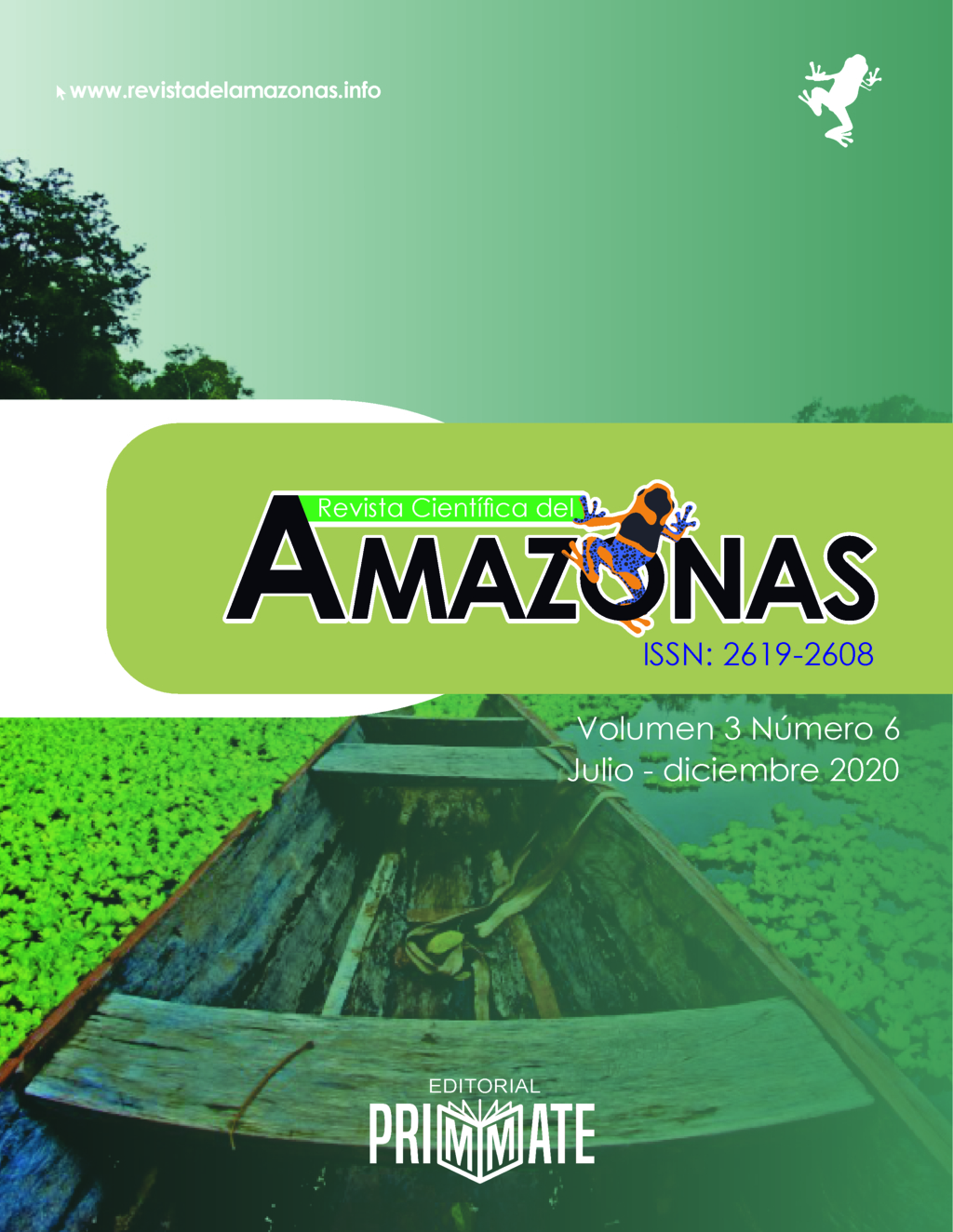Ethnobotanical characterization of Lawsonia inermis L. in the José Martí Norte District, Santiago de Cuba.
DOI:
https://doi.org/10.34069/RA/2020.6.01Keywords:
ethnobotanical studies, Lawsonia inermis L, medicinal plants, tradicionals uses.Abstract
An ethnobotanical study of the species Lawsonia inermis L. was carried out in the Popular Council "District Jose Martí Norte", municipality of Santiago de Cuba, with the objective of characterizing the use of the species, aiding in the established methodology for ethnobotanical studies, using as Instrument an interview based on a survey that established the research program applied to the Caribbean popular medicine (TRAMIL). Quantitative ethnobotanical indicators were calculated: value of use index (IVU) and index of significant use level (NUS). 500 people were interviewed. The sex with the highest prevalence was female (64%); the most interviewed age group corresponded to between 31-40 years old; the senior high school level (36,8%) and the worker cathegory (68,6%) were the most represented within their respective categories. 426 people (85,2%) are aware of the specie and 327 (76,7%) of them use it. Seven uses were reported, the most reported being to calm the nerves with 312(95,4%) citations. The aerial parts of the plant were the most used. 91% of the interviewed used the infusion method to obtain the medicinal product using the plant in the fresh state. The oral route resulted the most reported (98 %) form of administration. The values of the quantitative ethnobotanical indexes were of a value of IVU of 0.65 and NUS of 65% for the Popular Council, being Micro 9 locality that showed a greater knowledge of use of the specie.
Downloads
References
Blanché, C., Bonet, M.A., Muntané, J. y Vallès, J. (1996). Bases de datos en etnobotánica: elaboración de los resultados. Monografías del Jardín Botánico de Córdoba. 3, 63-68.
Bulut, G., Bozkurt, M.Z., y Tuxlac, E. (2017). The preliminary ethnobotanical study of medicinal plants in U?ak (Turkey). Marmara Pharm J.21(2), 1-6
Cakilcioglu, U., y Turkoglu, I. (2010). An ethnobotanical survey of medicinal plants in Sivrice (Elaz??g-Turkey). Journal of Ethnopharmacology. 132, 165–175.
Chaibi, R., Romdhane, M., Ferchichi, A., y Bouajila, J. (2015). Assessment of antioxidant, anti-inflammatory, anti-cholinesterase and cytotoxic activities of Henna (Lawsonia inermis) flowers. Journal of Natural Products. 8, 85-92.
Claus, P., y Tyler, E. (1989). Farmacognosia. La Habana, Cuba: Ed. Revolucionaria. pp. 8-9
Clement, N., Baksh-Comeau, S., y Seaforth, E. (2015). An ethnobotanical survey of medicinal plants in Trinidad. Journal of Ethnobiology and Ethnomedicine. 11:67, pp. 1-28.
Del Hoyo, M.A. (2004). Estrés laboral. Documento divulgativo. Ed. Instituto Nacional de Seguridad e Higiene en el Trabajo. Madrid: ISBN: 84-7425-474-4. Disponible en: https://www.sesst.org/2Fwp-content/2Fuploads/2F2018/2F08/2Festres-laboral-guia.pdf. [Acceso: 30 may. 2018].
El Babili, F., Valentin, A, y Chatelain, Ch. (2013). Lawsonia inermis: Its Anatomy and its Antimalarial, Antioxidant and Human Breast Cancer Cells MCF7 Activities. Pharmaceut Anal Acta. 4(1), 2-6
Gagandeep, C., Sandeep, G., y Priyanka, P. (2010). Lawsonia inermis Linnaeus: A Phytopharmacological Review. International Journal of Pharmaceutical Sciences and Drug Research. 2(2), 91-98
Germosén-Robineau, L. (1995). Hacia una farmacopea vegetal caribeña. Edición TRAMIL 7. Santo Domingo: Enda Caribe, UAG & Universidad de Antioquia.
Guha, G., Rajkumar, V., Kumar, R., y Mathew, L. (2011). Antioxidant activity of Lawsonia inermis extracts inhibits Chromium(VI)-Induced cellular and DNA toxicity. Evidence-Based Complementary and Alternative Medicine. Vol. 2011, 1- 9
Heredia, Y., García, J., López, T., Chil, I., Arias, D., Escalona, J.C., González, R., Costa, J., Suarez, D., Sánchez, M., y Martínez, Y. (2018). Estudio etnobotánico de las plantas medicinales usadas por los habitantes de Holguín, Región Oriental, Cuba. Boletín Latinoamericano y del Caribe de Plantas Medicinales y Aromáticas. 17(2), 160 – 196
Hernández, J.,yVolpato, G. (2004). Herbal mixtures in the traditional medicine of Eastern Cuba. Journal of Ethnopharmacology. 90, 293–316 (pendiente agregar en el texto a Volpato)
Illnait, JF. (2007). Principales referencias etnomédicas sobre el Anamú. Revista CENIC. Ciencias biológicas. 38(1), 27-30.
Jain, C., Shah, P., Sonani, G., Dhakara, S., y Patel, M. (2010). Pharmacognostical and Preliminary Phytochemical Investigation of Lawsonia Inermis L. Leaf. Rom. J. Biol. – Plant Biol. 55(2), 127–133
Kamal, M, y Jawaid, T. (2010). Pharmacological activities of Lawsonia inermis Linn: a review. IJBR. 1(2), 62-68.
Kumar, M., Chandel, M., Kaur, P., Pandit, K., Kaur, V., y Kaur, S. (2016). Chemical composition and inhibitory effects of water extract of henna leaves on reactive oxygen species, DNA scission and proliferation of cancer cells. EXCLI Journal. 15, 842-857
Kumar, M., Kaur, P., Chandel, M., Singh, A.P., Jain, A., y Kaur, S. (2017). Antioxidant and hepatoprotective potential of Lawsonia inermis L. leaves against 2-acetylaminofluorene induced hepatic damage in male Wistar rats. BMC Complementary and Alternative Medicine. 17:56. 1-11
Macías, E., Coy, D., y Suárez, E. (2011). Análisis fitoquímico preliminar y actividad antioxidante, antiinflamatoria y antiproliferativa del extracto etanólico de corteza de Zanthoxylumfagara (L.) Sarg. (Rutaceae). Revista Cubana de Plantas Medicinales. 16(1), 43-53.
Mamoona, N., Muhammad, H.Z., Abdul, G. (2016). Complete Prospective of Lawsonia inermis Linn- Review. Imperial Journal of Interdisciplinary Research. 2(2), 190-197.
Martin, G.J. (1995). Ethnobotany: a methods manual. Londres: Chapman & Hall.
Martínez, J.V., Bernal, Y., Henry, A., y Cáceres, A. (2000). Fundamentos de agrotecnología de cultivo de plantas medicinales iberoamericanas. Revista Cubana de Plantas Medicinales. 5(3), 125.
Miranda, M, y Cuéllar, A. (2001). Farmacognosia y Productos Naturales. La Habana, Cuba: Editorial Félix Varela. pp. 68,159.
Ochoa, A., Gross, C., Menéndez, M., Chacón, N., y Torres, M. (1995). Propiedades antinflamatorias del ungüento de Petiveria alliaceae L. Rev Cub Farm. 30(S), 143.
OMS. (2002). Estrategias de la OMS sobre la Medicina Tradicional 2002-2005. WHO/EDM/TRM/2002.1, Ginebra, Suiza. Disponible en: https://www.google.com/search?source=hp&ei=J-PrXruYBoa1ggevsK-oBQ&q=OMS.+/282002/29.+Estrategias+de+la+OMS+sobre+la+Medicina+Tradicional
ONEI. (2015). Oficina Nacional de Estadística e Información. Anuario Estadístico Santiago de Cuba 2014. Edición 2015. Disponible en: http://www.one.cu/aed2014/34Santiago/20de/20Cuba/Municipios/06/20Santiago/20de/20Cuba.pdf
Pardo, M., y Gómez, E. (2003). Etnobotánica: Aprovechamiento tradicional de plantas y patrimonio cultural. Anales Jard. Bot. 60(1), 171-182.
Pérez, M., Sueiro, M., Boffill, M., Morón, F., Marrero, E., Rodríguez, M., Méndez, R., y González, M. (2011). Estudio etnobotánico de las plantas más utilizadas como diuréticas en la Provincia de Villa Clara, Cuba. Bol Latinoam Caribe Plant Med Aromat. 10(1), 46-55.
Pérez, Y., Vázquez, A., Suárez, F., Rodríguez, E., y Baró, Y. (2009). Plantas antidermatofíticas, utilizadas en comunidades costeras del municipio Guamá, Santiago de cuba. Rev. Etnobiol. 7, 56-62
Phillips, O. (1996). Some quantitative methods for analyzing ethnobotanical knowledge. In Alexiades, M.N. (ed.). Selected guidelines for ethnobotanical research: A field manual. New York: The New York Botanical Garden, Bronx.
Pimentel, O. (2002). Estudio Etnobotánico de las plantas medicinales en el Valle de San Andrés. Pinar del Río Cuba. Monografias. Disponible en: https://www.monografias.com/2Ftrabajos71/2Festudio-etnobotanico-plantas-medicinales/2Festudio-etnobotanico-plantas-medicinales2.shtml
Rodríguez, Y., Valdés, M., Hernández, H., y Soria, S. (2019). Guía metodológica para estudio etnobotánico de especies forestales en comunidades amazónicas y afines. Revista Cubana de Ciencias Forestales. 7(1), 98-110
Roig, J.T. (2012). Plantas medicinales, aromáticas o venenosas de Cuba. La Habana, Cuba: Editorial Científico-Técnica. pp. 818-819.
Santosh, Y., Anil, K., Jyotsna, D., y Ashok, K. (2013). Essential Perspectives of Lawsonia inermis. International journal of pharmaceutical and chemical sciences. 2(2), 888-896
Sharma, R.K., Goel, A., Bhatia, A.K. (2016). Lawsonia inermis linn:a plant with cosmetic and medical benefits. Int J Appl Sci Biotechnol. 4(1), 15-20
Soto, O.R. (2002). La domesticación de las plantas medicinales en cuba: importancia y experiencias concretas. Biocenosis. 16 (1-2), 66-70.
TRAMIL. (2018). (Traditional Medicine in the Islands). Requerimientos de encuestas. Programa de investigación aplicada a la medicina popular del Caribe, República Dominicana. Encuestas TRAMIL. Disponible en: http://www.tramil.net/es/content/modeloencuestas
Vargas, B., Pupo, Y., Puertas, A., Mercado, I., y Hernández, W. (2011). Estudio etnobotánico sobre tres especies Arvenses en localidades de la región Oriental de Cuba. Revista Granma Ciencia. 15(3).
Vila, J.L. (2001). Tecnología Farmacéutica. Vol. II. España: Editorial Síntesis. p.55.

























